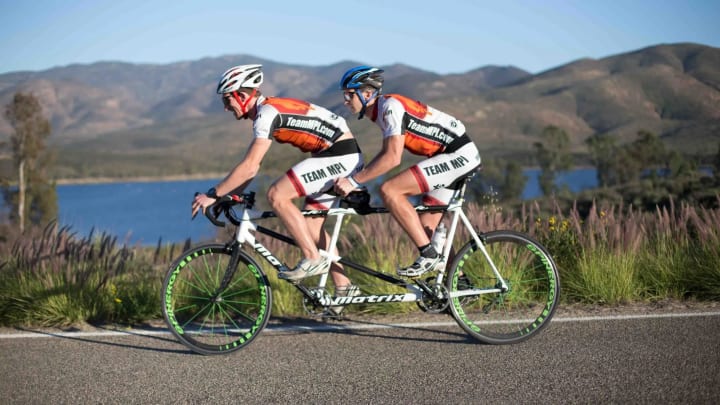
My Road
It was like I’d vanished. Like I had slept through my alarm clock and missed the starting gun.
I ran the fastest time in the 2008 Malibu Triathlon, but after the race, someone told me that my name didn’t appear on the leaderboard. Like I had never swum, biked or run the race.
I’d never won and lost at the same time before.
There’s no doubt our society has made enormous strides in better accommodating and understanding the disabled community, but as a blind triathlete who competes at the highest levels of the sport, I’m afraid that our society does not yet fully embrace disabled athletes competing in traditionally able-bodied events.
There is something ironic about Americans’ understanding of disability. If you are an athlete with a disability competing at the level of an average American, you will be praised and applauded. (This is a good thing.) But if you are an athlete with a disability competing at an elite able-bodied level, like I have done for years, you might be questioned by spectators, interrogated by race officials, kicked out of competitions, and even called a cheater. (Not so great.) This has been my experience.
At the root of the controversy is a misunderstanding of visual impairment itself. At the same Malibu Triathlon, a race official wondered aloud whether I was actually blind. I didn’t even know what to say because, how do you prove that? I was offended, but at the same time I was also motivated: I’m pretty sure he was only saying that because he didn’t believe I could be that good if I was blind. That race official’s reaction wasn’t uncommon — there’s a lot of misunderstanding about the meaning of “blind.” Some people seem to believe blindness is black and white thing: You either have 20/20 vision or you’re living in total darkness. It doesn’t work like that. Only about 10 percent of the visually impaired are totally blind.
The rest are “legally blind,” which I have been since birth. This means I can’t drive. I can’t read a book. I can’t watch a movie — to name a few things. All I can see are shapes of light and shadow. Writing this piece, for instance, was extremely time consuming because I had to use a computer program to read back the text. I can type from muscle memory, but I make a lot of errors.
When I’m running, I can’t see signs, cones or obstacles that are five feet in front of me. It would be extremely dangerous not to have a sighted guide when I’m racing.
Due to this misunderstanding about blindness, I was the “inspiration” for a racing rule, instituted in 2011, that blind athletes must wear “blackout glasses” to ensure we are 100 percent in the dark. The rule was intended to “level the playing field,” but in reality its effect was to humiliate and dismiss visually impaired athletes. More importantly, the rule was dangerous because blackout glasses increase the possibility of injury. It took legal action to abolish the rule and create a fair system where disabilities are embraced, not enhanced. I felt so strongly against the “blackout glasses” that I vowed not to compete in any triathlon that would institute this rule. This decision involved forfeiting many racing opportunities, but in the end it led to positive change. The rule was abolished later that year and now I hope people better understand why the rule was misguided.
Here’s how, as a blind athlete, I have to do triathlons: A sighted guide does every stage of the race with me. The guide swims next to me in the water and runs next to me on the road, attached at the waist by a bungee tether. The guide cannot go in front of me as to pull or pace me. On the bike, I ride a tandem bicycle with the sighted guide on the front and me on the back. I must find someone that is an equally strong athlete in all disciplines to serve as my eyes.
The other major misunderstanding I run into is that I have a “competitive advantage.” I was competing at the LifeTime Fitness Triathlon in Minneapolis in 2003 when the heckling began. As my guide and I rode the bike portion of the race on the tandem, one spectator yelled out, “That’s not fair, that’s cheating.” My guide yelled back defensively, “Well, is it fair that he can’t see?”
This leads me to the myth I refer to as, “Two People, Twice the Speed.” I am constantly asked, “Twice the power must mean twice the speed, right?” Not exactly. There are situations where a tandem can be an advantage and situations where it can be a disadvantage. But also, a tandem bike is my only means to participation — blind triathletes cannot ride a single bike. The only thing I’ve ever asked is to be able to compete alongside elite able-bodied athletes.
If two people were equal to twice the speed, then any tandem bike on a flat road should never go under 30 mph on a slow day. But twice the people also means two times the force of gravity, which is an exponential factor working on that weight. A tandem is like a semi truck — it is slow going up hills and slow at cornering, but on a straight flat section with momentum it can get going quickly.
People often ask, “Does your guide pedal? How is that fair?”
Yes, the guide pedals, but you have to consider that the bike is heavier and the two of us have to coordinate our pedaling motion, so it doesn’t result in doubling my speed. If anything, biking is the part of the triathlon that’s the slowest and most frustrating for me. Yes, I have to rely on a sighted guide throughout a race. But I’ve never argued that it’s easy to exactly compare my race time to an able-bodied racer’s time. I have always just said that there should be more understanding about what it takes for me to race at elite levels.
The higher the level of competition, the more I hear about the “advantage” debate. When people bring it up, I just say, Look at the numbers. I’ve put myself in the test lab on a stationary bike and had the numbers analyzed. A functional threshold power of 360W and a power-to-weight ratio of just under 5.0 W/kg is comparable to elite cyclists. Those who tell me I have an advantage by riding a tandem never want to consider that maybe I am actually at a disadvantage. Should I make the argument to these individuals that, if my guide on the front can’t match or supersede those power outputs, they are actually slowing me down by not contributing equally?
Sometimes disabled athletes are in a court of law as much as we are competing in our sports. I find it quite ironic that nearly every athlete with a disability competing at an elite level in “able-bodied” sport has been forced to resort to legal action in order to compete. There are a lot of examples, but they don’t always make the mainstream media.
Golfer Casey Martin had a congenital defect in his leg the prevented him from walking long distances. His golf game was up to par with others on the PGA tour (today he’s the University of Oregon golf coach), but as he got closer to qualifying for PGA events, he was told that because he had to use a cart on the course, he had an unfair advantage over the rest of the athletes that walk the course. His case was in court for years, but in the end, he was successful.
At the New York City Triathlon a few years ago, I was set to race head-to-head against elite triathletes, and was told if I did so, I would receive a five-year ban from the sport from my federation. When my guide was having a tough day and all I wanted to do was race to my potential, so I asked a spectator to run with me, I was disqualified from the race and later kicked off the national team. There is no question I have tested the waters and maybe even rubbed people the wrong way along the way, but I have made it known that I am not satisfied with only competing in disability categories. It’s experiences like these that make me wonder if we are ready as a society to accept that a person with a disability can compete at the top level of “able-bodied” sport.
If you’ve read this far, you might be thinking, I’m sorry you have a disability, but why can’t you race in the Paralympics or in other competitions made for visually impaired athletes? I can understand the question on some level, but that’s just the reason I’m writing this: disabled athletes, like me, who can race at an elite level, want to compete with the best athletes in the world. That’s what makes sports sports. If it makes some people uncomfortable or if it makes it harder to compare times or give awards, so be it. Competition is always evolving, and so can our attitudes about it.
One of my life goals is to get society to change its perception on athletes with disabilities. I am flattered that some people may look at me as an “inspiration,” but disabled athletes are not just inspirational stories. We are competitors, and we are just as talented and hard-working as many able-bodied athletes out there.
My hope is that when the next elite athlete with a disability emerges into the elite “able-bodied” world, the response by society will not be, “Well, he must have some sort of advantage,” but rather, “Dang, that guy is a ferocious competitor.”
Title image by Marcy Browe Photography. Images in body by Seattle Flashing Lights Photography.

